India: The First Victim
By
Israel Shamir
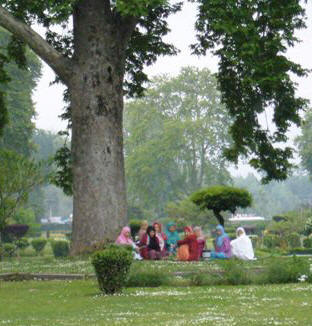 India
is as warm and comfortable as ever. Over thirty years have passed since
I roamed around in her cities and temples as a young long-haired
white-cotton-trousered journalist cub, but coming back is easy. Things
on the ground have not changed much – but they have changed.
India
is as warm and comfortable as ever. Over thirty years have passed since
I roamed around in her cities and temples as a young long-haired
white-cotton-trousered journalist cub, but coming back is easy. Things
on the ground have not changed much – but they have changed.
It is
the same dense, busy crowd in Old Delhi, but the terrible poverty and
hunger has disappeared or been pushed away. There are beggars, but they
appear to be Gypsy professionals who reputedly fly to summer vacation
sites for their short season, rather than disaster-stricken Bihar
peasants, who ask for our charity.
It is
the same immense green lawns of the British-built New Delhi, but now
they are frequented by middle class families picnicking in their Sunday
garb.
Centuries-old Mughal gardens are bristling with visiting ladies clad in
exquisite polychrome saris and with striped pyjama-fashion grey
squirrels, but the palaces are in good repair and visitors do not feel
threatened by their imminent collapse.
The
smell of curry and baking bread still sojourns with that of jasmine and
mango, but the once prevalent smell of Indian tobacco (I was almost
arrested for smoking their fags in Europe) has practically disappeared.
Indians are almost saints: they do not smoke, do not drink alcohol and
they rarely eat meat.
They
are modest shoppers and modest dressers, though now there are decent
western-style shops. The feet of Indians are still bare, but clean and
pedicured. There are many jobless, but whoever has a job manages well
even on a low salary. Now even lower middle class families have
servants, as in 19th century Europe, and not just temporary
help – real servants with separate duties: cooks, drivers, cleaners,
errand boys. Cars and bikes have multiplied a hundred times in the past
thirty years, but they still incessantly honk their horns.
Their
sergeant-majors still boast the most fearsome moustaches and sideburns,
but now they have nuclear weapons to boast about too. Next time, when
imperial soldiers advance to India thinking “Whatever happens, we have
got // The Maxim gun, and they have not”, they will be mistaken. India
now has an impressive army with a goodly amount of arms; they have
launched a few satellites and are on the way to becoming a power in
space.
|
Indian Pundits
With their nuclear armoury and modest
affluence, Indians are being heard today
in the West – better than they were in
the days of poverty, hunger and
weakness. “The Wisdom of a poor man is
despised”, says the Writ. Now we pay
attention to Indian political thinkers,
not only to the gurus. I had the honour
to meet a few of the like-minded people
in
India. We
publish Indian writers here. Among them,
there is
Ambassador Gajendra Singh, a man
with first-hand knowledge of the Middle
East,
Turkey and
East Europe. Another one is J C
Kapur, whose text delivered in
St Petersburg
University is
published here as well. We have also
published
Ambassador Bhadrakumar and
Satya Sagar. Come Carpentier, a
French expatriate living in
India, Lille
Singh, an Indian expatriate in
New York, Syed Zaidi of
Delhi -- all participate
in our deliberations. We also publish
and cherish the essays of Arundhati Roy
and other Indian thinkers. |
|
|
It is
not that India needs much of an army; but nukes and missiles are a
modern way to prove a country’s virility. That is why the US and Israel
are so stubbornly fighting against other countries having them – they
want to be the only males in the harem with a few eunuchs on the side.
They are trying to take Indian nukes under their control, too – and some
say that the last India-US agreement is nothing less than a
capitulation. I am not so sure: the Indian leaders have not acquiesced
in the US drive against Iran, and this is an important criterion.
President Ahmadinejad was better received in Delhi than President Bush.
Another reason is the old tie: Persian was to India what French was to
the rest of Europe, the language of civilisation and poetry.
Instinctively India, historically its first victim, can’t support the
Empire against Iran. Today this Empire covers much of the unipolar
world; it subdued Germany and Japan in two world wars, Moscow submitted
in 1991, and since 2003, the Arab world is also cowed. But it began as a
small trading post in East India. The British were the first carriers of
modern Empire, and India was subdued by them centuries ago. We say “the
British Empire, the American Empire”, but actually these countries were
and are rather carriers of the Empire than her owners. The Empire is an
independent parasite, the Alien, feeding on many nations including its
proud carrier and enforcer. Gladstone was right in his argument against
Disraeli: empire is not good for the mother country. Now, worn-out
Britain is a junior partner in the enterprise; its head offices have
moved from London to Washington and New York.
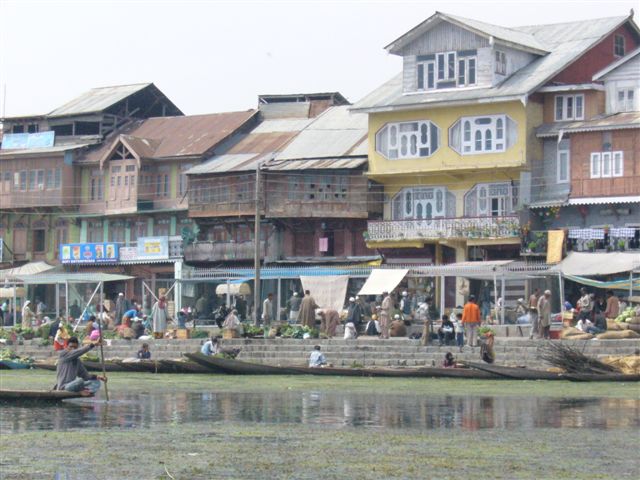
India
was the laboratory for imperial devices. A long time before Baghdad was
looted by the Americans, British troops in 1799 conquered and looted
Seringapatam, the fortress capital of Mysore, and killed (beside tens of
thousands of natives) Sultan Tipu, who twice defeated the Brits and who
had nearly reverted the crawling colonisation of India. The Sultan was
described as an “infamous tyrant, usurper and ruler of the most perfect
despotism in the world”, the same title later ascribed to Saddam
Hussein. All the horrors of occupation ever experienced by the enemies
of the Empire were visited on Delhi in 1857, when British troops
slaughtered millions of Indians in what was probably the greatest
holocaust the world had ever known up to that time.
Still, Indians nurse no ill feelings towards the Brits. They fought and
died by their tens of thousands for England in the WWI and WWII. Now
they are proud to be part of the Commonwealth, happily speak English,
shop on Oxford Street and visit their relatives in Earls Court. The
old-timers miss the British days (perhaps it is the time of their youth
they miss). Captain Nemo with his dream of vengeance was, after all,
invented by the French writer Jules Verne, not by an Indian. Indians are
not vengeful by nature. English is also the lingua franca of this
huge country and, by default, the language of many wonderful Indian
writers, from Arundhati Roy to Salman Rushdie, who would be unknown
outside of their provinces. Thanks to the ubiquity of English, India is
the preferred country for outsourcing, and this has provided it with
considerable income.
The
new Indian affluence is thinly spread. There were always rich Indians,
and that’s why there were always so many poor Indians. Even for
outsourcing and similar crumb-sharing schemes, Indians pay a high price:
Western companies have made huge inroads into the Indian economy. The
courts do not defend ordinary Indians against the multinationals. They
could take a leaf from the Canadians, who ruled in favour of a
farmer against Monsanto in 2008. The countryside remains very poor,
but the country is so huge, and there are so many people, that the lower
middle class is quite numerous, and even they have servants aplenty.
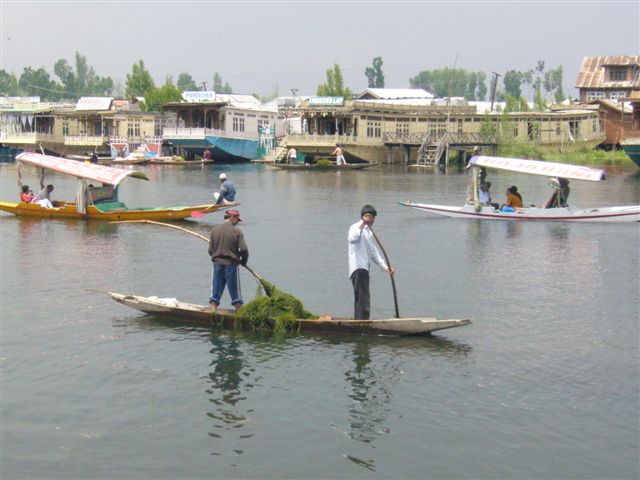
Until
recently, the Empire placed its bet on Pakistan -- now India has become
stronger and more attractive. This is a fateful hour – if India should
once again become its crown jewel, the Empire would engulf China and
undermine South East Asia. The US continues flirting with India,
offering American weaponry while demanding that it toe the line on Iran
and China, and some forces in India are ready to embrace the Americans.
It is therefore all the more important to keep India friendly to China,
to Russia, to Iran and the Muslim world.
The
bottom line is that India today is not as strongly anti-imperialist as
she was in the days of Nehru and his friendship with Nasser, Tito and
Fidel, but she has not switched sides completely, either. She is rather
biding her time, playing cricket.
Despite the rise of Hindu fundamentalism, fuelled (and paid for) by
second-generation Indian Americans and by the US State Department, India
is not a natural enemy to the Muslim world. It's the other way around:
sixty years after the Partition, North India (including Delhi) has a
distinctly Muslim flavour. If Pakistan had not been created, Islam would
probably predominate in India. The founders of Pakistan had a strange
idea that the Hindus would seek revenge on their former masters; as a
result, some space was vacated, leaving room for a Hindu revival. This
revival is not entirely natural, as revivals go: they built in Delhi a
vast, bright and garish complex of Hindu temples. The statues of Hindu
gods, terrifying and bewildering when venerable and old, give the
impression of a kind of Disneyland when shining and new. Films like
Ramayana have filled in the chasm between the sacred and profane,
and one is left wondering: are these the statues of gods or of movie
characters? This is not to say that the Hindu religion is dead: there
are millions of small shrines on every corner, and all passers-by do
their obeisance. These small shrines are islands of calm in the
turbulent world, and surely they are greatly needed and appreciated.
However, the mosques in the Indian capital are still much more
impressive than the Hindu temples. Everything pre-British is
Muslim-built, as for a thousand years, ever since Mahmud of Ghazna, the
rulers of Hindustan have been Muslims. The warlike neighbours of pacific
Indians, - Afghanis, Central Asians, Persians and Turks conquered North
India and colonised it. They were quite tolerant and friendly to their
non-Muslim subjects, giving the lie to modern claims that Muslims are
harsh rulers when it comes to infidels. Judging by Indian films, they
lived well together in mutual respect. Not that I consider Indian films
an authority on history, but surely they express some popular feeling on
the subject.
The
invaders of the 16th century became fully subsumed in India. Hindus and
Muslims venerate the same tombs of the same saints and celebrate the
same feasts. I tried to provoke my Muslim Indian friends by asking them:
“Aren’t you upset by seeing Indian idols? Shouldn’t one remove them?”
But they did not even understand the thought: “They worship one way, we
worship other way; God is anyway one and the same for all of us”, they
replied. Many native Indians embraced Islam, and eventually Islam became
as Indian as Hinduism or Buddhism.
Subsuming Colonisers
The
British could have followed
in the steps of Muslim
incomers to become subsumed
ex-colonisers, and William
Dalrymple, a sensitive and
knowledgeable author, wrote
at length in his White
Mughals: from the
days of Clive and to 1820s,
the Brits tended to conform
to the local habits. They
went native, married local
women, many of them
converted to Islam or, to a
lesser extent, to Hinduism,
and thus they formed a part
of the Indian upper classes.
The change came later, when
the British women were
brought in. They formed a
fighting sorority and
excluded the Indian wives
and their children from
society interaction. Since
then, fearing ostracism, the
British Indians separated
themselves from native
Indian society, and their
children of Indian women
could not rise up in the
world. Instead of conforming
to
India, and
gently adjusting to her
ways, they tried to erase
her culture and reshape her.
Instead of slowly becoming
Indians, they became enemies
of
India. Rudyard
Kipling,
India born and
bred, proved it by his
Kim: all his knowledge
of
India may
serve only the Intelligence
Service.
This
weather change from
absorption and integration
to separation did not happen
just because of English
ladies’ malice. The
communications between
India and
England
rapidly improved, so the
ties between the settlers
and their mother country
could be maintained. If the
communications were poor and
difficult, or artificially
severed, the settlers would
be integrated. In case of
Israel/Palestine, if the
ties between the Israelis
and their “mother country”,
the World Jewry, were
severed, the Israelis would
be easily absorbed in
Palestine.
It is
true for other ex-colonial
states, as well. Settlers
and their children are
valuable asset, and it would
be mistake to get rid of
them. Due to colonial
injustice, they are better
trained and have important
and useful professions. This
injustice can’t be corrected
by mass expulsion or by mass
flight.
Algeria is a
good example: the French
departed, taking with them
practically all educated
Algerians and leaving the
country without teachers and
doctors. On the other hand,
Spain was forced
to give up its possessions
in
America, but
Spanish settlers remained,
and guaranteed continuity.
Africa suffered much because of
this traumatic
decolonisation. White
settlers left in droves, and
the newly independent
countries had to invite
experts instead of using
people familiar with local
reality. Thus,
colonists-settlers should be
subsumed, rather than
expelled.
|
|
|
|
Kashmir
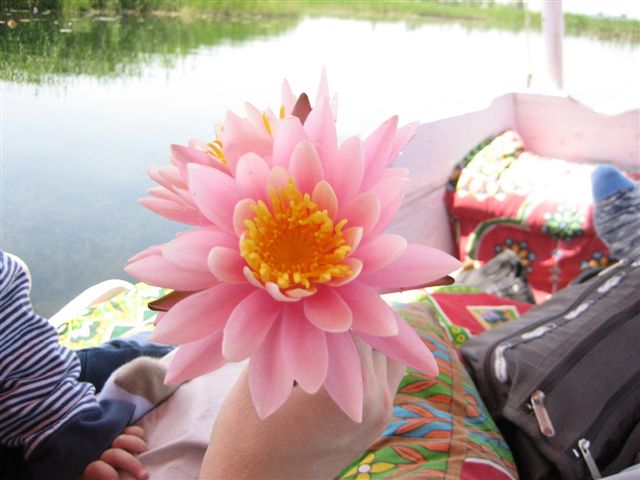
Kashmir, a chain of pleasant green mountain valleys was the most
cherished patrimony of the Great Mughals, who embellished it with
palaces and gardens. Here the Muslims and Hindus lived together in peace
and harmony. However, the Empire did not will it. At first, there was a
Hindu-Muslim conflagration which resulted in the Partition. Still, the
Hindu refugees quickly came back to the Valley after the battles were
over. Peace had returned, but not for long. The American meddling in
Afghanistan in 1970s-80s had undermined stability. The Americans created
Islamist insurgency to embroil the Russians in the fire of guerrilla war
in neighbouring Afghanistan. Sparks of the insurgency ignited fire in
North India, and soon the villages and towns were engulfed by
fratricidal struggle. The Hindus were forced to leave Kashmir and move
to Jammu and other places; many Muslims had left too, rather than being
forced to serve the firebrand insurgents. Their empty, ruined or burned
down houses still stick out in Srinagar and elsewhere, though many of
the properties were sold for a song during the insurgency.
This
was a tragic development. Kashmiris – Muslims and Pandits (as local
Hindus are called) are ethnically and linguistically the same people,
they have the same family names. My host in the Valley, Ustad Bashir
Butt, told me of their affinities and of good neighbourhood relations.
He is a devout Muslim, but there are Pandit Butts as well, sharing the
same ancestry. Butts saved lives of their Pandit neighbours during the
militants’ raids, though mainly they were preoccupied with staying
alive. Disappearance of the Pandits is a tragedy for them, and for all
Kashmiris.
This sad
situation is relevant for
Israelis and Palestinians.
The Palestinians were
forcibly expelled by the
Jewish militants in 1948,
and since then they are not
allowed to come back. But
will they if they can? I am
on record of being in full
support of al-Awda, of
Palestinian refugees’ right
of return, but I do not know
whether many ex-Palestinians
would like to come back. The
Pandits of Kashmir may come
back, after all,
India is
not a Muslim
fundamentalist state, and
Hindu parties are close to
power. They may, but
they do not come – even from
nearby
Jammu. They say they
have nothing to go back to:
their houses are burned or
taken over. The Pandits are
not an exception. Though it
is not easy, the German
exiles may come back
to Sudetenland in
Czech
Republic and to
Poland; but
somehow they do not. They
come for a visit, but do not
stay there for long. It can
be the case in
Palestine, too.
|
|
|
|
Now
Kashmir is calm and pleasant to visit. Militancy died out, but not many
potential Western tourists know of it, and you may now enjoy summer in
Srinagar for knock-down prices. There are newly prosperous Indian
tourists from Bombay and Delhi, but Western tourists are rare. This is
the best time to go to Srinagar, the valley’s summer capital.
A
delightful place, to be sure, this town on the Dal Lake, in the shade of
mighty Himalayas. It is often compared with Venice, but our Italian
friend, who is a permanent resident there, corrected the image: Srinagar
may become Venice, but meanwhile it is a Venice of AD 500. The canals
and lagoons of the city are not yet fixed and built up and polished to
perfection. Imagine the Grande Canale with fishermen’s huts instead of
majestic palaces, the Piazza di San Marco covered with cucumber gardens
and Rialto full of water lilies instead of pizza stands, and you’ll get
the image of Srinagar.
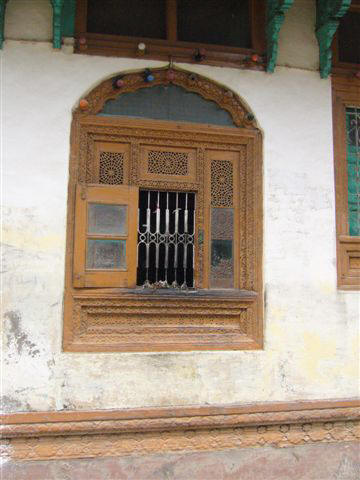 The
lake is covered with grass, and this grass is collected by local
peasants who roam the lake on their small boats. The grass is used as
fertiliser in their tiny gardens which produce amazing harvests. They
build floating gardens, and cultivate every bit of land; the plentiful
canals dissect the islands, so it is difficult to decide whether you
view an island crossed by canals or a part of lake with floating
gardens. These grass-collecting boats compete with local gondolas
“shikaras” carrying tourists and sightseers and doing taxi job. The
scene of this pre-Venice lagoon is very lively and quite unique.
The
lake is covered with grass, and this grass is collected by local
peasants who roam the lake on their small boats. The grass is used as
fertiliser in their tiny gardens which produce amazing harvests. They
build floating gardens, and cultivate every bit of land; the plentiful
canals dissect the islands, so it is difficult to decide whether you
view an island crossed by canals or a part of lake with floating
gardens. These grass-collecting boats compete with local gondolas
“shikaras” carrying tourists and sightseers and doing taxi job. The
scene of this pre-Venice lagoon is very lively and quite unique.
Around the lake, there are magnificent formal gardens laid by the
Mughals, and the mountains are nearby for trekking or fishing. The town
is also a charming place, especially the house of British representative
now turned into emporium of local arts and crafts. There is a strange
place often described as “Jesus Tomb”. A local legend says that Jesus
after resurrection moved to Srinagar and lived here, happily married,
until his death. Perhaps it is the burial place of an early Christian
preacher or an apostle. I have brought there the candles lit at the Holy
Sepulchre in Jerusalem, and left them at this sanctuary.
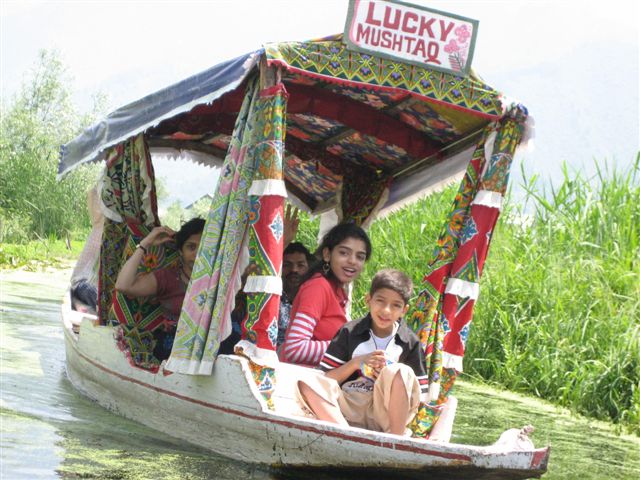
In
the days of the Raj, the English colonial administrators loved to spend
summer in Srinagar and other hill stations, but the Raja did not allow
them to buy land for the houses they wanted. As a solution, the Brits
turned to build luxurious houseboats, small floating palaces and villas.
After Independence, they were gone, and the houseboats were extremely
popular place for hippies and other travellers in 1970s and 80s. By the
end of 80s, civil war was raging, and the hippies moved
to
Goa, but the houseboats remained.
All pictures in the
article were taken by the author in Kashmir: (1) Mughal Gardens, (2) (3)
Waterfront of Srinagar (4) Canals of Srinagar (5) “Jesus Tomb” (6)
Shikara
The best
houseboats in
Srinagar are
Clermont boats of Butt.
They are all traditional yet
thoroughly modernised,
equipped with best carpets,
handmade furniture of
valuable trees and
embroidery. What’s more,
they are moored at a
distance from the town, in a
Mughal garden Naseem Bagh
with its 400-year old chinar
trees planted by Akbar or
more probably by his art
loving son Jahangir. There
are only three boats, and
they are usually taken by
dignitaries and diplomats.
Yehudi Menuhin stayed there,
so did
Harrison the Beatle, a Rockefeller
and even yours truly. One
can easily find a cheaper
place, but this is the best,
ultimate in privacy and
Raj-style opulence. The
place is run by two Butt
brothers, very pleasant and
hospitable men. Contact
Bashir Butt, refer to us
and get a discount!
|
|
|
|

